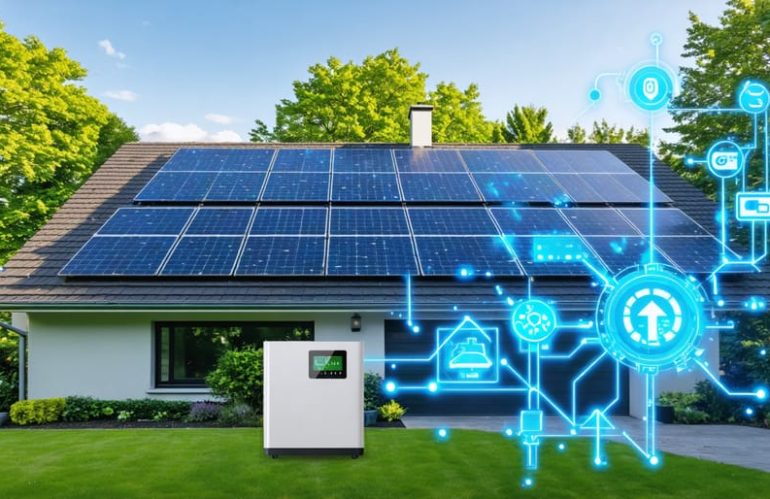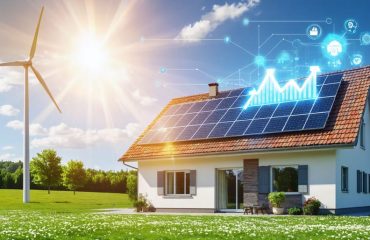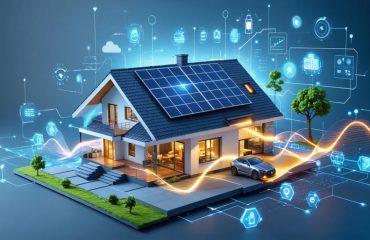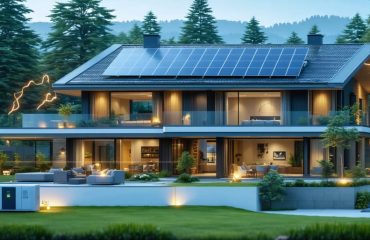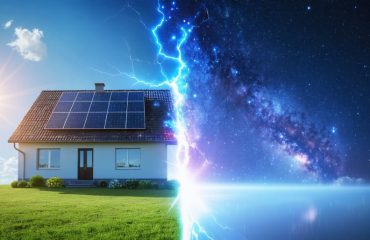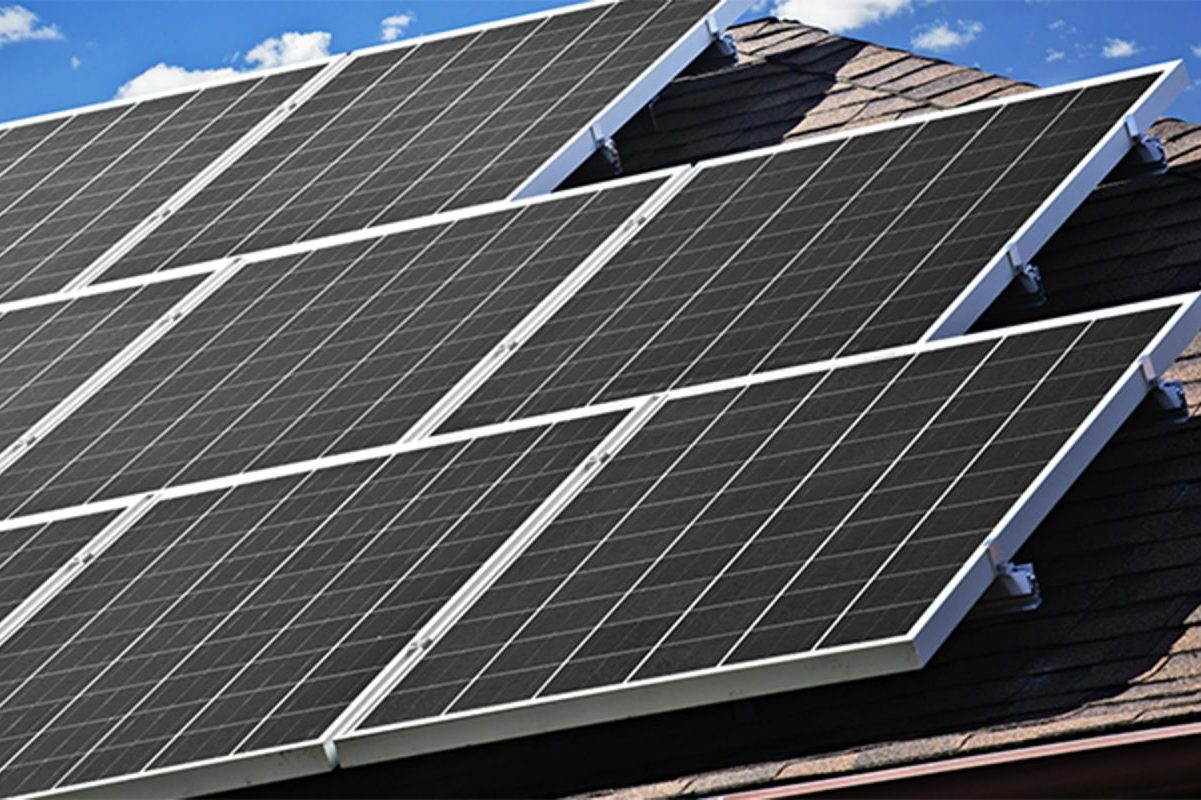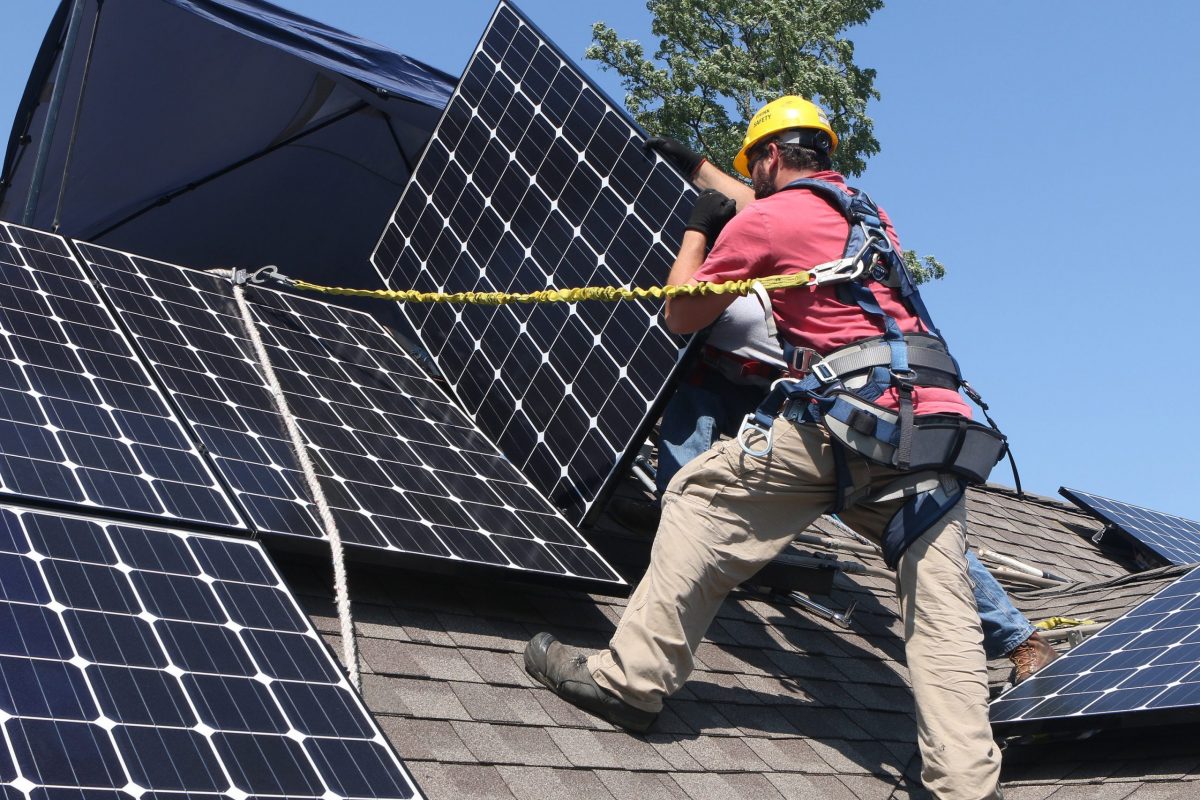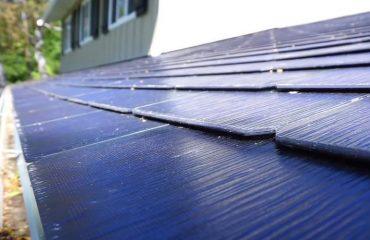Achieving complete energy independence through solar power isn’t just an environmental choice—it’s a powerful financial decision that transforms your home into a self-sustaining powerhouse. Modern solar technology, coupled with advanced battery storage systems, now makes it possible for homeowners to generate, store, and manage their own electricity year-round. This shift away from traditional utility dependence offers more than just lower monthly bills; it provides protection against rising energy costs, power outages, and grid instability while increasing property value.
The journey to energy self-sufficiency begins with understanding your household’s unique power consumption patterns and implementing a customized solution that matches your specific needs. Whether you’re looking to completely disconnect from the grid or maintain a minimal connection for backup purposes, today’s solar technology offers flexible, scalable options that adapt to your lifestyle and budget. With federal tax incentives, decreasing equipment costs, and improved battery technology, achieving energy autonomy has never been more accessible for the average homeowner.
Understanding Your Home’s Energy Needs
Conducting a Home Energy Audit
A home energy audit is your first step toward energy independence. Start by examining your utility bills from the past year to establish your baseline energy consumption. Next, inspect all windows and doors using your hand to feel for drafts, or use a smoke pencil for more precise detection. Check your insulation levels in the attic, walls, and basement – proper insulation can reduce energy needs by up to 15%.
Survey your lighting setup, noting how many bulbs are still traditional incandescent versus LED. List all major appliances with their age and energy ratings, paying special attention to heating, cooling, and water heating systems, which typically account for 60% of home energy use.
Document electronics and their standby power consumption using a basic power meter. Examine your roof’s condition and sun exposure to assess solar potential. Finally, check your water usage patterns, including hot water consumption and any leaky faucets.
Create a prioritized list of improvements based on your findings, focusing on changes that offer the biggest energy-saving potential for your investment. Consider professional assessment for complex issues like HVAC efficiency or thermal imaging analysis.
Peak vs. Off-Peak Consumption
Understanding your daily energy consumption patterns is crucial for achieving energy self-sufficiency. Most households experience two distinct usage periods: peak hours, typically from late afternoon to early evening when everyone’s home, and off-peak hours during the night and midday when usage is lower.
During peak hours, you might be running multiple appliances, heating or cooling systems, and lights simultaneously. This creates a high demand that your self-sufficient energy system needs to meet. Off-peak periods, however, offer opportunities to store excess energy for later use, especially if you’re using solar panels that generate power during daylight hours.
To properly size your energy system, track your consumption patterns for at least a few months. Smart meters and energy monitoring devices can help you understand when you use the most power. This information is invaluable for determining the capacity of solar panels, batteries, and other components you’ll need. Consider shifting some high-energy activities to off-peak hours when possible, as this can help reduce the overall size and cost of your system while maintaining reliable power throughout the day.

Designing Your Solar Power System
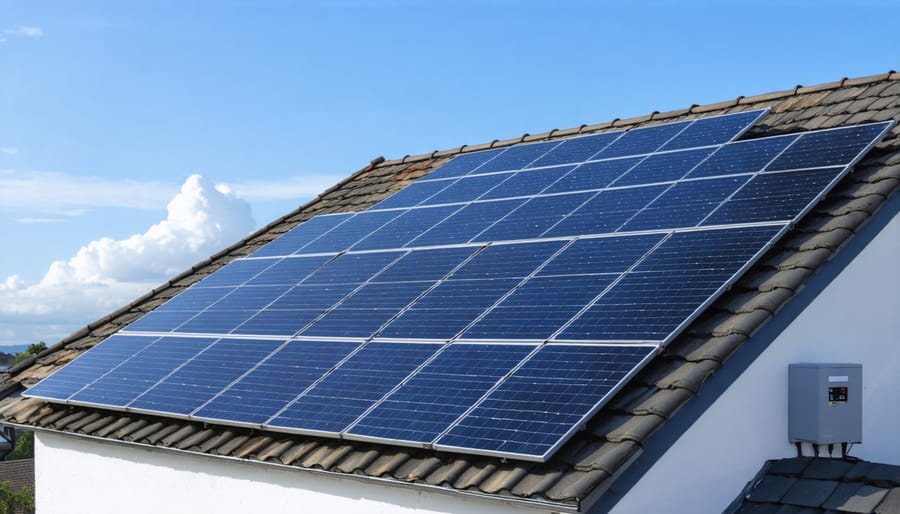
Solar Panel Configuration
Choosing the right solar panel configuration is crucial for creating a self-sufficient solar system. For residential installations, monocrystalline panels are typically the best choice, offering higher efficiency and a smaller footprint than their polycrystalline counterparts. These panels convert about 15-22% of sunlight into electricity, making them ideal for homes with limited roof space.
The optimal placement of your panels depends on your location and roof orientation. In the Northern Hemisphere, south-facing panels typically generate the most power, with a tilt angle roughly equal to your latitude. For example, if you live at 40° latitude, your panels should be tilted at approximately 40 degrees for best year-round performance.
To determine the right system size, start by calculating your average daily energy consumption in kilowatt-hours (kWh). A typical American home uses about 30 kWh per day, requiring approximately 20-24 panels for complete energy independence. However, your specific needs may vary based on energy usage patterns and local climate conditions.
Consider installing additional panels beyond your current needs to account for future energy demands and potential efficiency losses over time. This forward-thinking approach ensures your system remains effective for years to come while maximizing your investment in sustainable energy.
Energy Storage Solutions
Modern home battery storage solutions are essential for achieving true energy self-sufficiency. Today’s lithium-ion batteries offer exceptional performance and longevity, with most systems lasting 10-15 years. When planning your storage capacity, consider your daily energy usage and peak demand periods to ensure adequate coverage during cloudy days and nighttime hours.
A typical residential battery system ranges from 10-15 kWh, sufficient for most households’ essential needs. Some homeowners opt for multiple batteries to increase their storage capacity and backup duration. Smart battery systems can automatically manage energy flow, storing excess solar power during peak production and releasing it when needed.
Popular options include wall-mounted units that integrate seamlessly with existing solar setups and floor-standing systems for larger capacity needs. Many modern batteries also include smartphone apps for real-time monitoring and control, allowing you to track energy usage and storage levels from anywhere. When selecting a system, consider factors like warranty length, round-trip efficiency, and compatibility with your current or planned solar installation.
Backup Power Integration
While solar panels provide reliable energy during sunny days, a comprehensive backup power system ensures your energy independence around the clock. Modern backup solutions combine generators and smart grid connections to create a seamless power supply for your home.
A hybrid inverter system allows you to automatically switch between solar, battery storage, and backup power sources. When selecting a generator, consider propane or natural gas options, which offer cleaner operation and longer fuel storage life than traditional diesel generators. Many homeowners opt for a 7-10kW generator, which can power essential appliances during extended outages.
Grid connection remains a practical choice for most self-sufficient homes, acting as a safety net and allowing you to sell excess power back to utilities through net metering programs. This approach, known as grid-tied with battery backup, offers the best of both worlds – independence when you want it and reliability when you need it.
Your backup power strategy should align with your specific needs, climate conditions, and local regulations. Consider working with a qualified energy consultant to design a system that provides peace of mind without unnecessary complexity.
Smart Energy Management Strategies
Load Shifting Techniques
Load shifting is a smart strategy that helps you maximize your energy independence by aligning your power consumption with your energy production patterns. The basic principle is simple: use more energy when your solar panels are generating plenty of power, and less when they’re not.
Start by scheduling energy-intensive activities during peak sunlight hours, typically between 10 AM and 4 PM. This includes running your dishwasher, washing machine, or charging electric vehicles when solar production is at its highest. Many modern appliances come with delay timers, making it easy to automate this process.
Smart home technology can take load shifting to the next level. Programmable thermostats can pre-cool your home during sunny hours, reducing the need for air conditioning in the evening. Similarly, water heaters can be set to heat water primarily during daylight hours, storing hot water for later use.
Battery storage systems play a crucial role in load shifting by storing excess daytime energy for nighttime use. Even without batteries, you can create “thermal storage” by using your home’s natural heat retention properties. For example, running your heating system during sunny hours can keep your home comfortable well into the evening.
Consider using smart plugs and energy monitoring systems to track and optimize your consumption patterns. These tools help you identify opportunities for better load shifting and measure the impact of your efforts.
Monitoring and Automation
Modern smart energy management systems are revolutionizing how homeowners monitor and control their energy consumption. These intelligent platforms provide real-time insights into your energy production and usage patterns, helping you make informed decisions about when to use major appliances or store excess power.
With user-friendly smartphone apps and intuitive dashboards, you can track your solar panel performance, battery storage levels, and household energy consumption from anywhere. Many systems offer automated features that adjust your home’s energy usage based on weather forecasts, peak utility rates, and your daily routines.
For example, these systems can automatically run energy-intensive appliances like washing machines or dishwashers when solar production is at its peak, or switch to battery power during high-rate periods. Some platforms even learn from your habits, optimizing energy flow without requiring constant manual adjustments.
Weather prediction integration helps prepare your system for upcoming cloudy days by ensuring batteries are fully charged, while fault detection alerts you to any maintenance needs before they become serious issues. Many systems also generate detailed reports on your energy savings and carbon footprint reduction, helping you track your progress toward complete energy independence.
This level of automation not only maximizes your system’s efficiency but also provides peace of mind, knowing your home is intelligently managing its energy resources around the clock.
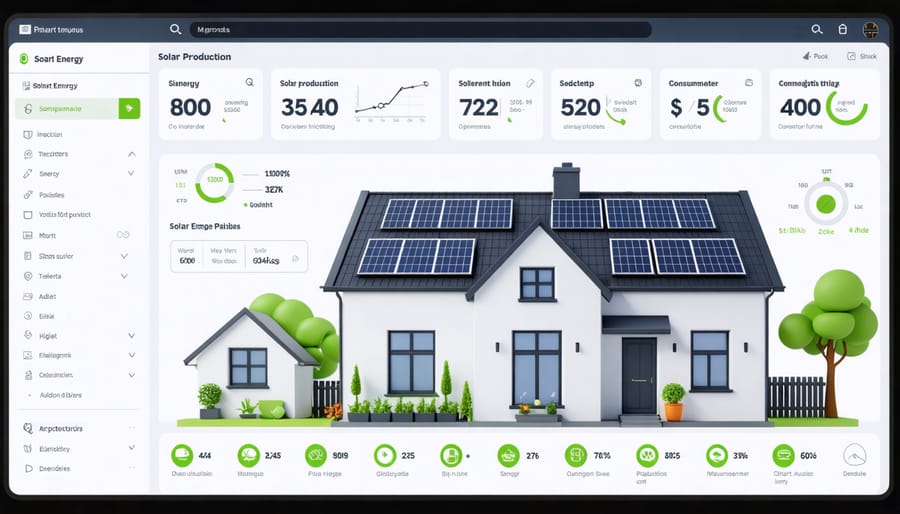
Financial Benefits and ROI
Initial Investment vs. Long-term Savings
While the initial investment in energy self-sufficiency can seem substantial, the long-term financial benefits often outweigh the upfront costs. A typical home solar system installation ranges from $15,000 to $25,000 before incentives, but federal tax credits can reduce this by up to 30%. Many states offer additional rebates and incentives, potentially lowering costs by thousands more.
The real value becomes apparent when considering long-term savings. Most homeowners see their electricity bills drop by 50-90% immediately after installation. With average household energy bills reaching $2,000 annually, this can translate to savings of $1,000 to $1,800 per year. Over a 25-year period (the typical lifespan of solar panels), total savings can exceed $30,000, accounting for inflation and rising energy costs.
Battery storage systems add approximately $8,000-$15,000 to initial costs but provide crucial independence from the grid and protection against power outages. While this increases the upfront investment, it also enhances property value – homes with solar systems typically sell for 4.1% more than comparable properties.
Maintenance costs are minimal, usually averaging less than $200 annually for basic inspections and cleaning. Most quality solar panels come with 25-year warranties, ensuring reliable performance and peace of mind throughout their lifetime.
Available Incentives and Tax Benefits
Making the switch to energy self-sufficiency comes with attractive financial incentives that can significantly reduce your initial investment. The federal solar tax credit, also known as the Investment Tax Credit (ITC), allows you to deduct 30% of your solar installation costs from your federal taxes through 2032. This substantial benefit applies to both residential and commercial installations.
Many states offer additional tax incentives, rebates, and grants for solar installations. These can include property tax exemptions for the added home value from solar systems, sales tax exemptions on equipment purchases, and performance-based incentives that pay you for the energy your system produces.
Net metering programs, available in most states, allow you to earn credits on your utility bill for excess energy your system feeds back into the grid. Some utility companies also provide special time-of-use rates and solar-specific programs that can maximize your savings.
Local governments and municipalities may offer additional incentives, such as expedited permits or reduced fees for solar installations. Some areas even provide low-interest financing options or PACE (Property Assessed Clean Energy) programs that let you finance your solar system through property tax assessments.
Remember that incentives vary by location and can change periodically, so it’s worth consulting with local solar installers or energy efficiency experts to understand the current opportunities in your area.
Becoming energy self-sufficient is an achievable goal that offers lasting benefits for both your household and the environment. By implementing the strategies discussed throughout this article, from solar panel installation to energy-efficient upgrades and smart home technology, you can significantly reduce or eliminate your dependence on the power grid.
Start your journey by conducting a thorough energy audit of your home and identifying areas for improvement. Consider beginning with smaller, cost-effective changes like LED lighting and smart thermostats before moving on to larger investments such as solar panels or energy storage systems. Remember that government incentives, tax credits, and financing options can make these improvements more affordable than you might think.
The path to energy independence requires careful planning and may take time, but the long-term rewards are substantial: lower utility bills, increased property value, and protection against rising energy costs. Plus, you’ll have the satisfaction of knowing you’re contributing to a more sustainable future.
Take action today by scheduling an energy assessment with a qualified professional who can help create a customized plan for your home. With the right approach and commitment, energy self-sufficiency is within reach for any homeowner willing to make the transition to a more sustainable lifestyle.

